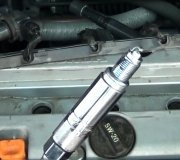None of the parts you listed are going to cause this symptom. If the engine runs, the crankshaft position sensor is working. The front oxygen sensors have very little effect on engine performance, and then only once the engine is warmed up. The rear oxygen sensors monitor the efficiency of the catalytic converters, and nothing else.
Be careful with non-original spark plugs. There are a real lot of instances where split-fire plugs and other unusual designs cause all kinds of running problems. They will never solve a problem that has some other cause. You will feel a spark problem as a definite misfire, and that often only occurs under load, as in when accelerating.
There are three good suspects to start with. The first is low fuel pressure. My 1988 Grand Caravan calls for 45 - 50 psi, and while chasing an elusive intermittent problem, I drove around for a year and a half with a fuel pressure gauge attached. I found that engine would still run fine, with no symptoms at all, down to 20 psi. 15 psi is when the first surging was observed. In contrast, there are some engines that will not start or run properly if fuel pressure is low by as little as 5 psi. I am not sure where your engine falls between those two extremes. With a pressure gauge attached, you will learn very quickly what "normal" is, then you can watch what happens when the problem occurs. On most systems, fuel pressure should drop when intake manifold vacuum goes up, as in coasting. If pressure drops too much, suspect a fuel volume problem. The main cause for that is a plugged pick-up screen inside the gas tank. Pressure should go up when accelerating and vacuum is low. That maintains an even overall force working on the molecules of fuel in the injector nozzles. If pressure does not go up, suspect a weak pump. This is the same time when volume goes down, so it should be real easy for the pump to raise pressure.
The next thing to consider is all manufacturers except Chrysler rely on a mass air flow sensor for their main fuel metering calculations on most of their engines. Readings from all the other sensors simply tweak those calculations a little. A common cause of stumbling and hesitations is a leak in the fresh air tube between the sensor and the throttle body. If any air sneaks in that doesn't go through the mass air flow sensor, it will not be measured, and no fuel will be commanded to go with it. That will result in an excessively-lean fuel/air ratio. Lean mixtures are hard to ignite because the flame front has to jump from one molecule to the next, and it is harder to do that when those molecules are further apart. If the mixture does burn, it develops less than normal power. If the mixture fails to burn, that often gets diagnosed incorrectly as a spark-related misfire. Be sure there is no cut in the fresh air tube, and the hose clamps are tight.
Related to the lean misfire, check for a vacuum leak. If that is bad enough, idle speed will be too high. There will not be fuel to go with that additional air, the high idle will include lower power. The Engine Computer has control of idle speed, but its control is limited. It can overcome the slightly-higher idle caused by a small vacuum leak, but you still will not get the fuel to go with it. The computer lowers idle speed by reducing the amount of air allowed to bypass the throttle blade, and shortening the amount of time the injectors are pulsed open. Reducing the volume of air corrects for some of the unknown air leaking in, but reducing the amount of fuel results in a lean condition.
SPONSORED LINKS
Sunday, February 26th, 2017 AT 5:20 PM





